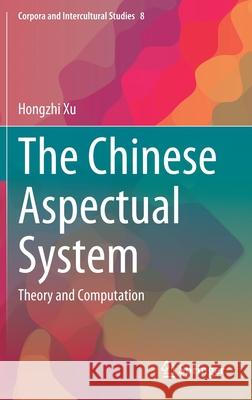The Chinese Aspectual System: Theory and Computation » książka
topmenu



The Chinese Aspectual System: Theory and Computation
ISBN-13: 9789811634079 / Angielski / Twarda / 2021 / 278 str.
The Chinese Aspectual System: Theory and Computation
ISBN-13: 9789811634079 / Angielski / Twarda / 2021 / 278 str.
cena 645,58
(netto: 614,84 VAT: 5%)
Najniższa cena z 30 dni: 616,85
(netto: 614,84 VAT: 5%)
Najniższa cena z 30 dni: 616,85
Termin realizacji zamówienia:
ok. 22 dni roboczych
Bez gwarancji dostawy przed świętami
ok. 22 dni roboczych
Bez gwarancji dostawy przed świętami
Darmowa dostawa!
Kategorie:
Kategorie BISAC:
Wydawca:
Springer
Seria wydawnicza:
Język:
Angielski
ISBN-13:
9789811634079
Rok wydania:
2021
Wydanie:
2021
Numer serii:
000817330
Ilość stron:
278
Waga:
0.58 kg
Wymiary:
23.39 x 15.6 x 1.75
Oprawa:
Twarda
Wolumenów:
01
Dodatkowe informacje:
Wydanie ilustrowane
Chapter 1. Introduction
1.1. What is Aspect
1.1.1. Definition of Aspect
1.1.2. Studies on Chinese Aspectual Markers
1.1.3. Studies on Aspectual Classification
1.1.4. Situation Aspect vs. Viewpoint Aspect
1.2. The Goal of the Study
1.3. Methodology
1.4. Thesis Organization
Chapter 2. Previous Studies
2.1. Situation Aspect and Vendler’s Classes
2.2. Aspectual Classification
2.2.1. Feature-Based Methodology
2.2.2. The Conceptual Structure
2.2.3. The Generative Lexicon
2.2.4. MARVS
2.3. Diagnostics for aspectual classification
2.4. Difficulties in Aspectual Classification
2.4.1. Degree Achievements
2.4.2. More than Degree Achievements
2.4.3. Achievement vs. Accomplishment
2.4.4. The term ‘telicity’
2.4.5. Intention and Perception
2.5. Aspectual Studies on Chinese
2.6. Summary
Chapter 3. Event Structure and Event Types
3.1. Ontological Situation Types
3.1.1. Representation of Ontological Situation Types
3.1.2. Progressive is Stative
3.1.3. Primitives of Events
3.1.4. Theoretically Existing Situation Types
3.2. Linguistic Events
3.2.1. Viewpoint Aspect
3.2.2. Linguistic Event: Combination of Situation and Viewpoint Aspect
3.2.3. What expresses the ontological situations and what to classify?
3.3. Where Is Telicity From?
3.3.1. Intentionality
3.3.2. Result
3.3.3. Perception and Prediction
3.3.4. Context
3.3.5. Summary of Telicity
3.4. Linguistic Event Types
3.4.1. Static State: |----|
3.4.2. Dynamic State: |~~~|
3.4.3. Change of State: ==|==
3.4.4. Semelfactive: |~|
3.4.5. Accomplishment: |~~~|==
3.4.6. Instantaneous Accomplishment: |~|==
3.5. Constructions and Their Aspects
3.5.1 Resultative Verbal Complements (RVCs)
3.5.2. Resultative DE construction
3.5.3. Serial Verb Constructions (SVCs)
3.5.4. V+(ZHE/LE/GUO)+O+(LE)
3.5.5. BA construction
3.5.6. BEI construction
3.6. Summary
Chapter 4. Semantics of Aspectual Markers and Negators in Chinese
4.1. Introduction
4.2. Aspectual Operators
4.3. 了 LE
4.3.1. LE with static state
4.3.2. LE with dynamic state
4.3.3. LE with accomplishment
4.3.4. LE with achievement
4.3.5. The Two LEs: LE1 and LE2
4.3.6. LE is not a tense marker
4.3.7. Non-Aspectual LE
4.4. 着 zhe0 ‘ZHE’, 在 zai4 ‘ZAI’ and 正在 zheng4zai4 ‘ZAI’
4.4.1. The difference of 在 zai4 ‘ZAI’ and 正在 zheng4zai4 ‘ZAI’
4.4.2. The Difference of Static State with and without ZHE and their relation with Negators
4.4.3. The difference of ZHE and LE in existential sentences
4.5. 过 guo4 ‘GUO’
4.5.1. Grammaticality and World Knowledge
4.5.2. Time Frame of GUO
4.5.3. The Truth Condition of GUO
4.6. Negations
4.6.1. 不 bu4
4.6.2. 没有 mei2you3
4.7. Summary
Chapter 5. Formal Representation of Aspect
5.1. Introduction
5.1.1. Second Order Logic
5.1.2. Predicates and Parameters
5.1.3. Class, Instance and Subclass
5.1.4. Attributes, Functionalities and Habits
5.1.5. Instances of Situations
5.1.6. Multi-modal Predicates in Natural Language
5.2. The Basic Predicates Related to Time
5.3. Representations for Ontological Situations
5.3.1. Representations for state and change of state
5.3.2. Representations for Complex Situations
5.4. Linguistic Event Types
5.4.1. Static State: ---
5.4.2. Delimitative State: |---|
5.4.3. Instant Dynamic State: ~~~
5.4.4. Activity: |~~~|
5.4.5. Semelfactive: |~|
5.4.6. Change of State: --|--, --|~~, ~~|--, ~~|~~
5.4.7. Accomplishment: |~~~|--, |~~~|~~
5.4.8. Instantaneous Accomplishment: |~|--, |~|~~
5.5. Chinese Aspectual Markers
5.5.1. 了 le0 ‘LE’
5.5.2. 着 zhe0 ‘ZHE’ and 在 zai4 ‘ZAI’
5.5.3. 过 guo4 ‘GUO’
5.5.4. Negators
5.6. Summary
Chapter 6. Annotating a Chinese Corpus for Aspectual Study
6.1. Introduction
6.2. Annotation Framework
6.2.1. Event Annotation
6.2.2. Illocutionary Acts
6.2.3. Modalities
6.2.4. Sentence Type Hierarchy
6.3. Some Constructions in Chinese
6.3.1. Serial Verb Constructions (SVCs)
6.3.2. Resultative Verbal Constructions (RVCs)
6.4. Annotating a Chinese Corpus
6.4.1. Data Selection
6.4.2. Data Annotation
6.4.3. Annotation Result
6.4.4. Agreement Test
6.5. Summary
Chapter 7. Automatic Aspectual Classification Chinese Sentences
7.1. Introduction
7.2. Linguistic indicators for sentence type classification
7.2.1. Indicators for different event types
7.2.2. Indicators for modalities
7.2.3. Indicators for speech acts
7.3. Aspectual Classification
7.3.1. Grounding the Features
7.3.2. Feature Extraction
7.3.3. Classifiers
7.4. Experiments
7.4.1. Sentence Type Classification
7.4.2. Classification on Different Modalities
7.4.3. Classification on Different Speech Acts
7.4.4. Classification on Mid-Level Event Types
7.4.5. Classification on Different Accomplishments
7.4.6. Classification on Different Achievements
7.4.7. Experiments with predicated features
7.4.8. Discussions
7.5. Summary
Chapter 8. Conclusion
8.1. Summarization of the Thesis
8.2. Consequences of the Study
8.2.1. Ontology and Lexicon
8.2.2. Extended Generative Lexicon
8.2.3. Computational Semantics
References
Hongzhi Xu received his Ph.D. in Linguistics from The Hong Kong Polytechnic University and subsequently worked as a postdoctoral researcher at the Computer Science Department, University of Pennsylvania. He is now an assistant researcher at the Institute of Corpus Study and Application, Shanghai International Studies University. He has published important papers on ACL, COLING, and various aspects of linguistics and computational linguistics.
This book presents a theoretical study on aspect in Chinese, including both situation and viewpoint aspects. Unlike previous studies, which have largely classified linguistic units into different situation types, this study defines a set of ontological event types that are conceptually universal and on the basis of which different languages employ various linguistic devices to describe such events. To do so, it focuses on a particular component of events, namely the viewpoint aspect. It includes and discusses a wealth of examples to show how such ontological events are realized in Chinese. In addition, the study discusses how Chinese modal verbs and adverbs affect the distribution of viewpoint aspects associated with certain situation types.
1997-2025 DolnySlask.com Agencja Internetowa
Zobacz: Księgarnia Czeska | Wydawnictwo Książkowe Klimaty | Mapa strony | Lista autorów
KrainaKsiazek.PL - Księgarnia Internetowa
KrainaKsiazek.PL - Księgarnia Internetowa









